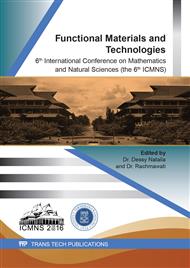[1]
M.A. Zulfikar, E. Novita, R. Hertadi and S.D. Djajanti, Removal of humic acid from peat water using untreated powdered eggshell as a low cost adsorbent, Int. J. Environ. Sci. Technol., 10 (2013) 1357-1366.
DOI: 10.1007/s13762-013-0204-5
Google Scholar
[2]
M. A. Zulfikar, I. Afrianingsih, M. Nasir and N. Handayani, Fabrication of nanofiber membrane functionalized with molecularly imprinted polymers for humic acid removal from peat water, Desalin. Water Treat. 97 (2017) 203-212.
DOI: 10.5004/dwt.2017.21443
Google Scholar
[3]
M.A. Zulfikar, Adsorption of Humic Acid from Aqueous Solution onto PVDF Nanofiber: Effect of Temperature, Mater. Sci. Forum 863 (2016) 123-126.
DOI: 10.4028/www.scientific.net/msf.863.123
Google Scholar
[4]
J.C. Rojas, J. Pérez, G. Garralón, F. Plaza, B. Moreno and M.A. Gómez, Humic acids removal by aerated spiral-wound ultrafiltration membrane combined with coagulation–hydraulic flocculation, Desalination 266 (2011) 128-133.
DOI: 10.1016/j.desal.2010.08.013
Google Scholar
[5]
J.H. Wang, S.R. Zheng, J.L. Liu, and Z.Y. Xu, Tannic acid adsorption on amino-functionalized magnetic mesoporous silica, Chem. Eng. J. 165 (2010) 10-16.
DOI: 10.1016/j.cej.2010.08.066
Google Scholar
[6]
C.S. Uygunera, S.A. Suphandaga, A. Kercb and M. Bekbolet, Evaluation of adsorption and coagulation characteristics of humic acids preceded by alternative advanced oxidation techniques, Desalination 210 (2007) 183-193.
DOI: 10.1016/j.desal.2006.05.043
Google Scholar
[7]
D. Sonea, R. Pode, F. Manea, C. Ratiu, C. Lazau, I. Grozescu and G. Burtica, The comparative assessment of photolysis, sorption and photocatalysis processes to humic acids removal from water. Chemical Bulletin of POLITEHNICA, Univ. (Timisoara) 55 (2010) 148-151.
Google Scholar
[8]
C. Sun, Q. Yue, B. Gao, R. Mu, J. Liu, Y. Zhao, Z. Yang and W. Xu, Effect of pH and shear force on flocs characteristics for humic acid removal using polyferric aluminum chloride organic polymer dual-coagulants, Desalination 281 (2011) 243-247.
DOI: 10.1016/j.desal.2011.07.065
Google Scholar
[9]
M.C.S. Reddy, L. Sivaramakrishna and A.V. Reddy, The use of an agricultural waste material, Jujuba seeds for the removal of anionic dye (Congo red) from aqueous medium, J. Hazard. Mater. 203-204 (2012) 118-127.
DOI: 10.1016/j.jhazmat.2011.11.083
Google Scholar
[10]
P.K. Malik, Use of activated carbons prepared from sawdust and rice-husk for adsorption of acid dyes: a case study of Acid Yellow 36, Dyes and Pigm. 56 (2003) 239-249.
DOI: 10.1016/s0143-7208(02)00159-6
Google Scholar
[11]
M. Toor and B. Jin, Adsorption characteristics, isotherm, kinetics, and diffusion of modified natural bentonite for removing diazo dye, Chem. Eng. J. 187 (2012) 79-88.
DOI: 10.1016/j.cej.2012.01.089
Google Scholar
[12]
Z. Ma and S. Ramakrishna, Electrospun regenerated cellulose nanofiber affinity membrane functionalized with protein A/G for IgG purification, J. Membr. Sci., 319 (2008) 23-28.
DOI: 10.1016/j.memsci.2008.03.045
Google Scholar
[13]
H. Zhang, H. Nie, D. Yu, C. Wu, Y. Zhang and C. White C, Surface modification of electrospun polyacrylonitrile nanofiber towards developing an affinity membrane for bromelain adsorption, Desalination, 256 (2010) 141-147.
DOI: 10.1016/j.desal.2010.01.026
Google Scholar
[14]
M. Aliabadi, M. Irani, J. Ismaeili, H. Piri and M. Parnian, Electrospun nanofiber membrane of PEO/Chitosan for the adsorption of nickel, cadmium, lead and copper ions from aqueous solution, Chem. Eng. J., 220 (2013) 237-243.
DOI: 10.1016/j.cej.2013.01.021
Google Scholar
[15]
M. Aliabadi, M. Irani, J. Ismaeili and S. Najafzadeh, Design and evaluation of chitosan/hydroxyapatite composite nanofiber membrane for the removal of heavy metal ions from aqueous solution, J. Taiwan Inst. Chem. Eng.. 45 (2014) 518.
DOI: 10.1016/j.jtice.2013.04.016
Google Scholar
[16]
D. Sharma, F. Li and Y. Wu, Electrospinning of Nafion and polyvinyl alcohol into nanofiber membranes: A facile approach to fabricate functional adsorbent for heavy metals, Colloids and Surf. A, 457 (2014) 236-243.
DOI: 10.1016/j.colsurfa.2014.05.038
Google Scholar
[17]
C. Peng, J. Zhang , Z. Xiong, B. Zhao and P. Liu, Fabrication of porous hollow-Al2O3 nanofibers by facile electrospinning and its application for water remediation, Microporous and Mesoporous Mater., 215 (2015) 133-142.M.
DOI: 10.1016/j.micromeso.2015.05.026
Google Scholar
[18]
Q. Xin, J. Fua, Z. Chen, S. Liu, Y. Yan and J. Zhang, Polypyrrole nanofibers as a high-efficient adsorbent for the removal of methyl orange from aqueous solution, J. Environ. Chem. Eng., 3 (2015) 1637-1647.
DOI: 10.1016/j.jece.2015.06.012
Google Scholar
[19]
R. Xu, M. Jia, Y. Zhang and F. Li, Sorption of malachite green on vinyl-modified mesoporous poly(acrylic acid)/SiO2 composite nanofiber membranes, Microporous and Mesoporous Mater., 149 (2012) 111-118.
DOI: 10.1016/j.micromeso.2011.08.024
Google Scholar
[20]
F.F. Liu, J.L. Fan, S.G. Wang and G.H. Ma, Adsorption of natural organic matter analogues by multi-walled carbon nanotubes: Comparison with powdered activated carbon, Chem. Eng. J. 219 (2013) 450-458.
DOI: 10.1016/j.cej.2013.01.026
Google Scholar
[21]
M.A. Zulfikar, and H. Setiyanto, Study of the adsorption kinetics and thermodynamic for the removal of Congo red from aqueous solution using powdered eggshell, Int. J. ChemTech. Res., 5(4) (2013) 1671-1678.
Google Scholar
[22]
M.B. Amran and M.A. Zulfikar, Color removal of congo red dyestuff by adsorption onto phyrrophyllite, Int. J. Environ. Sci. 67 (2010) 911-920.
Google Scholar
[23]
H. Hiroyuki, M. Fukudas, A. Okamato and T. Kataoka, Adsorption of acid dye cross linked chitosan fibers equilibria, Chem. Engg. Sci. 48 (1994) 2267-2272.
DOI: 10.1016/0009-2509(93)80242-i
Google Scholar
[24]
M. Saker and S. Podar, Study of adsorption of methyl violet onto flyash, Proc. Ind. Annual Communication 31 (1994) 213-215.
Google Scholar
[25]
S.I. Lyubchik, A.I. Lyubchik, O.L. Galushko, L.P. Tikhonova, J. Vital, I.M. Fonseca, S.B. Lyubchik, Kinetics and thermodynamics of the Cr(III) adsorption on the activated carbon from comingled wastes, Colloid Surf. A - Physicochem. Eng. Asp. 242 (2004) 151-158.
DOI: 10.1016/j.colsurfa.2004.04.066
Google Scholar


